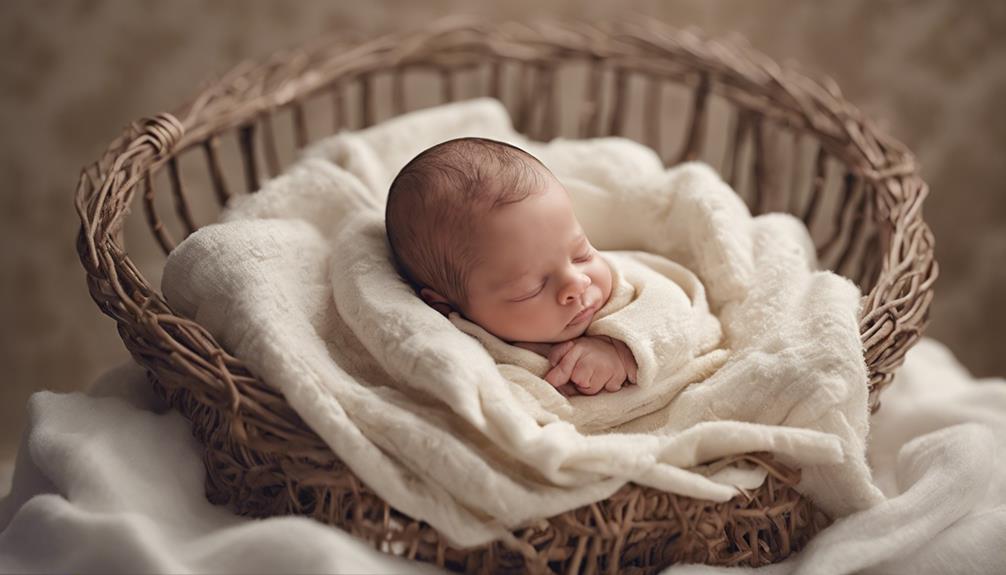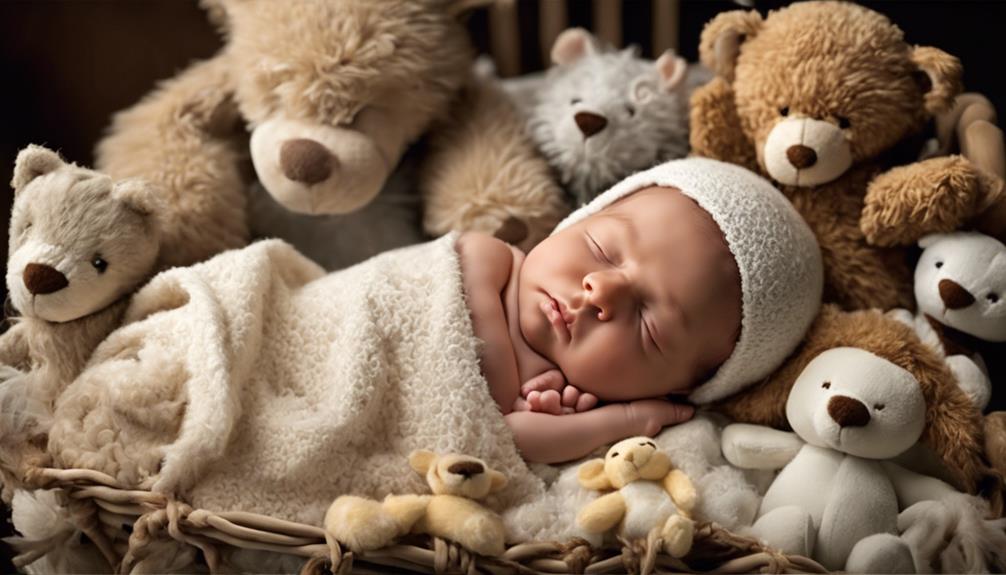We recognize the apprehension new parents face when pondering how their newborn will slumber without solely seeking solace in their arms.
The change to independent sleep can be a challenging task, but fret not, as there are practical strategies and innovative tools available to aid in this journey.
From establishing a soothing bedtime routine to introducing gentle sleep training techniques, there are ways to foster a restful environment for your little one.
Let's explore effective methods to support your newborn in embracing peaceful slumber beyond just being cradled by you.
Key Takeaways
- Establishing a consistent bedtime routine encourages independent sleep.
- Creating a comfortable sleep environment promotes self-soothing abilities.
- Implementing gentle sleep training techniques fosters healthy sleep habits.
- Seeking support from sleep experts for personalized guidance enhances baby's sleep independence.
Establishing a Consistent Bedtime Routine
Establishing a consistent bedtime routine is important for helping your newborn understand when it's time to sleep. As parents, it's essential to create a soothing environment to ease our little ones into relaxation before bedtime. Engaging in calming activities such as giving your baby a warm bath or a gentle massage can work wonders in preparing them for sleep. Additionally, reading a bedtime story or singing a lullaby can create a peaceful atmosphere that signals it's time for rest.
Dimming the lights and minimizing stimulation in the evening can also help set the stage for a good night's sleep. By following the same sequence of events each night, you can establish a predictable routine that your newborn will come to recognize and associate with sleep. Remember, the key is to provide a sense of security and comfort through these bedtime rituals, ultimately aiding your little one in drifting off to sleep peacefully.
Creating a Comfortable Sleep Environment

To make sure your newborn sleeps soundly, creating a comfortable sleep environment is important for their rest and well-being. When setting up your baby's sleep space, consider using blackout curtains to eliminate light distractions and maintain a cool, comfortable room temperature. Providing a vital sleep surface like a crib or bassinet is essential for your baby's safety and reduces the risk of Sudden Infant Death Syndrome (SIDS). Additionally, incorporating white noise machines or apps can help mask disruptive sounds and create a soothing atmosphere for your little one to drift off to sleep. Establishing a consistent bedtime routine with calming activities signals to your baby that it's time to sleep independently. Here is a helpful table summarizing key elements for creating a comfortable sleep environment:
| Key Element | Description |
|---|---|
| Blackout Curtains | Eliminate light distractions for better sleep |
| Room Temperature | Maintain a cool and comfortable environment |
| Firm Sleep Surface | Provide a safe crib or bassinet for sleeping |
| White Noise Machines | Mask disruptive sounds and promote peaceful sleep |
| Soothing Activities | Establish a bedtime routine with calming activities |
Implementing Gentle Sleep Training Techniques

When gently guiding your newborn towards independent sleep, consider implementing gradual techniques that support their self-soothing abilities.
- Establish Consistent Bedtime Routine: Create a calming bedtime routine to signal to your baby that it's time to sleep.
- Introduce a Lovey or Comfort Object: Encourage your baby to use a lovey or comfort object for self-soothing during sleep.
- Practice Gentle Sleep Training Methods: Use gentle techniques to help your baby learn to fall asleep independently.
- Foster Healthy Sleep Habits: By promoting self-soothing and independent sleep skills, you're setting the foundation for healthy sleep habits.
Encouraging Self-Soothing Practices

As we guide our newborn towards independent sleep, it's important to encourage the development of self-soothing practices that promote healthy sleep habits. Babies can start learning self-soothing techniques around 3 ½ – 4 months of age, making it a critical time to introduce methods that support their ability to soothe themselves to sleep. Teaching self-soothing skills not only fosters independent sleep habits but also helps in breaking the habit of always needing to be held, allowing babies to become more self-reliant.
Introducing self-soothing methods can greatly improve a baby's overall sleep patterns. It's crucial to start this process early, as babies older than 15 weeks are capable of beginning to learn self-soothing practices. By encouraging independence through self-soothing techniques, we can create a safe sleep environment where our little ones can learn to soothe themselves back to sleep, promoting better sleep for both baby and parents.
Seeking Support From Sleep Experts

Seeking guidance from sleep experts can provide invaluable support in helping your newborn develop healthy sleep habits without the constant need for you. When looking for assistance in getting your baby to fall asleep independently, turning to a Sleep Coach or Pediatric Sleep specialist can offer essential insights and strategies.
Here are some key points to take into account when seeking support from sleep professionals:
- Personalized Advice: Sleep experts can provide tailored guidance based on your baby's unique needs.
- Teaching Self-Soothing: Experts can help you learn effective methods of sleep training to encourage your baby to self-soothe.
- Addressing Challenges: Professionals can offer solutions for common issues like reflux that may impact your baby's ability to sleep well.
- Change Techniques: Sleep experts can recommend a Method of Sleep Training to gradually stop holding your baby during sleep, promoting independent sleep habits.
With the right support, your Baby Will Only Sleep with you can shift to a more restful routine where your little one sleeps soundly even without you being constantly present.
Conclusion
In the journey of helping our newborn sleep independently, we're guiding them towards a world of peaceful slumber and growth. Like a gentle lullaby leading them to dreamland, our efforts symbolize the love and care we provide to nurture their well-being.
Through patience, consistency, and support, we're creating a safe haven for our little one to rest and flourish. Together, we embrace this process with compassion and determination, knowing that good sleep is a precious gift for our child's development.









